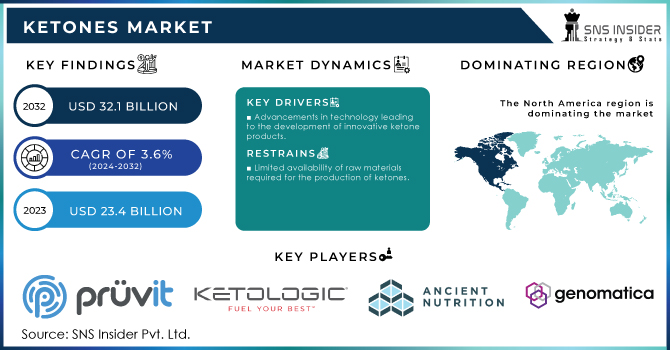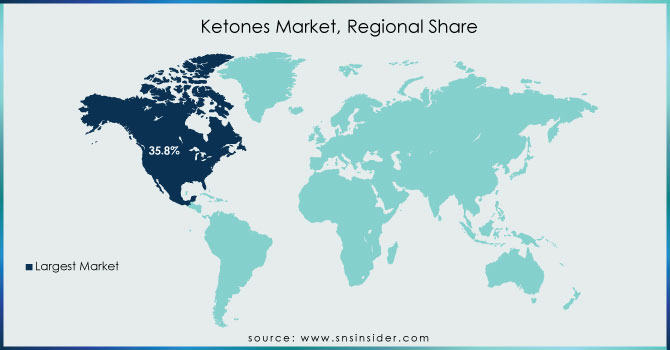Ketones Market Report Scope & Overview:
Ketones Market, valued at USD 24.24 billion in 2025E, is projected to reach USD 32.1 billion by 2033, growing at a CAGR of 3.6% from 2026 to 2033.
In the pharmaceutical sector, ketones play a crucial role in the synthesis of drugs and medications. They are utilized as intermediates in the production of antibiotics, antifungal agents, and anti-inflammatory drugs. The demand for ketones in the pharmaceutical industry is expected to witness substantial growth due to the increasing prevalence of chronic diseases and the need for effective treatments. Hence the demand for ketones market is growing in the market.
Market Size and Forecast:
-
Market Size in 2025E USD 24.24 Billion
-
Market Size by 2033 USD 32.1 Billion
-
CAGR of 3.6% From 2026 to 2033
-
Base Year 2025
-
Forecast Period 2026-2033
-
Historical Data 2022-2024

Get E-PDF Sample Report on Ketones Market - Request Sample Report
Ketones Market Trends:
-
Growing demand for ketone-based supplements and functional foods driven by consumer interest in weight management and fat-burning benefits.
-
Increasing adoption of ketones among athletes and fitness enthusiasts for enhanced energy, endurance, and mental clarity.
-
Expanding applications of ketones in healthcare, particularly for managing neurological disorders and cognitive health.
-
Rising consumer preference for natural and organic ketone products over synthetic alternatives.
-
Rapid innovation and diversification in ketone product offerings, including beverages, powders, and meal replacements.
The U.S. Ketones market size was valued at an estimated USD 9.10 billion in 2025 and is projected to reach USD 12.10 billion by 2033, growing at a CAGR of 3.1% over the forecast period 2026–2033. Market growth is driven by steady demand for ketones across key end-use industries such as pharmaceuticals, cosmetics, paints & coatings, and chemical manufacturing. Increasing use of ketones as solvents and intermediates in industrial processes, along with rising consumption in personal care and healthcare formulations, supports market expansion. Additionally, strong domestic chemical production capabilities, ongoing product innovations, and stable demand from downstream industries further contribute to the sustained growth outlook of the U.S. ketones market during the forecast period.
Furthermore, the food industry has recognized the potential of ketones as food additives. Ketones are used as flavor enhancers, providing a distinct taste and aroma to various food products. They are also utilized as food preservatives, extending the shelf life of perishable goods. With the rising demand for processed and convenience foods, the ketones market in the food industry is projected to experience substantial growth. The ketones market is driven by increasing consumer awareness regarding health and wellness, technological advancements in production processes, and the growing demand for natural and organic products. Additionally, the rising disposable income of consumers in emerging economies has contributed to the expansion of the ketones market.
Ketones Market Growth Drivers:
In recent years, there has been a significant surge in public awareness regarding the potential benefits of incorporating ketones into one's lifestyle. Ketones, which are organic compounds produced by the body during periods of low carbohydrate intake, have been found to play a crucial role in weight management and energy generation. Ketones have gained attention for their ability to aid in weight management. When the body enters a state of ketosis, where it primarily relies on ketones for fuel instead of glucose, it becomes more efficient at burning stored fat. This metabolic shift can lead to enhanced weight loss and improved body composition. Furthermore, the impact of ketones on energy production has also contributed to their growing popularity. This can result in heightened mental clarity, increased endurance, and improved physical performance. Athletes and individuals seeking sustained energy levels throughout the day have recognized the potential of ketones to optimize their performance and productivity. The combination of these factors has sparked a surge in demand for ketone-based products, ranging from dietary supplements to specialized food and beverages.
Ketones Market Restraints:
The scarcity of raw materials can be attributed to various factors, such as geographical limitations, environmental concerns, and supply chain disruptions. Geographically, certain regions may lack the necessary resources needed for ketone production, making it difficult to establish a reliable supply chain. Additionally, environmental concerns, such as regulations on the extraction or harvesting of specific raw materials, can further limit their availability.
Ketones Market Opportunities:
The ketone market is witnessing notable growth, driven by expanding applications in healthcare, particularly in the management of neurological disorders such as Alzheimer’s and epilepsy. At the same time, rising consumer inclination toward natural and organic products is fueling demand for naturally derived ketones. This dual trend highlights the growing importance of ketones not only as dietary supplements but also as therapeutic and clean-label solutions in health and wellness.
Ketones Market Segment Analysis:
By Supplement Type
The ketone oil segment accounted for the largest revenue share of 55% in 2025. This can be attributed to its antioxidant, anti-microbial, anti-inflammatory capabilities. Ketone oil is used in manufacturing cosmetics and personal care products as it is an ideal solvent for active ingredients and viscosity regulators, thus offering emollient properties in sunscreens, lotions, and other cosmetics and personal care products.
The ketone salts segment is expected to grow at the highest CAGR of 4.3% during the forecast period 2026-2033. This can be attributed to the ability of these salts to increase the blood ketone levels in a person without even following a keto diet just like ketosis and provide immense energy. These types of ketones are formulated with potassium, calcium, sodium, or magnesium to act as cations and are sold in powder, pills, and drink forms.
By Form
The liquid segment held the largest market share around 65% in 2025. They are also more universally applicable than any solid form since they can be mixed with any type of beverage. Liquid ketones can be administered by a consumer who follows a ketogenic diet or those who want to benefit quickly from the effects of ketones. Moreover, they are actively used across the board in the food and beverage industry as a flavor and preservative enhancer. Liquid forms are also easily adjustable in terms of dosing, which makes them both convenient for health support purposes and widely used in pharmaceutical applications.
By Application
Dietary supplements application segment dominated the ketone market with the largest revenue share of about 38% in 2025. This is attributed to the growing consumer awareness regarding personal health. The working population worldwide is focusing on consuming the daily nutrient necessities owing to changing lifestyles and work schedules which drive the growth of this segment.
Ketones Market Regional Analysis:
North America Ketones Market Insights
North America dominated the ketone market with the highest revenue share of about 35.8% in 2025. The United States is the major contributing country to this region’s growth. The surge in obesity cases across North America has led to a corresponding rise in the popularity of ketone supplements, food, and beverages as weight loss aids. Responding to the soaring demand from consumers, numerous hotels and restaurants in this region have incorporated ketone-based offerings into their menus. These factors collectively propel the expansion of the Ketones Market.
Asia Pacific Ketones Market Insights
Asia Pacific is expected to grow with the highest CAGR of about 3.9% in the ketone market during the forecast period 2026-2033. This growth is attributed to the increasing demand for natural products like ketones, driven by the expansion of the dietary supplements industry. The rise in obesity and weight-related disorders further contributes to this trend. The surge in dietary supplement sales in the Asia Pacific region can primarily be attributed to the busy schedules and high-stress levels of consumers, which have led to a rise in lifestyle disorders such as obesity, high blood pressure, and diabetes. Recognizing this, several sports nutrition product companies in the region are incorporating nutrients that support cognitive health and enhance overall mental, emotional, and physical well-being. As the demand for sports nutrition continues to grow, the market in the Asia Pacific region is expected to witness significant expansion during the forecast period.
Europe Ketones Market Insights
The Europe ketones market is expanding steadily, supported by rising demand for functional foods, dietary supplements, and performance-enhancing products. Growing consumer awareness of ketogenic diets, coupled with applications in healthcare for neurological conditions, is driving adoption. Additionally, strong regulatory support for clean-label and natural products enhances market growth. Innovation in ketone-based beverages and supplements positions Europe as a key region for both consumption and product development.
Latin America (LATAM) and Middle East & Africa (MEA) Ketones Market Insights
The ketones market in LATAM and MEA is gaining traction, driven by rising health consciousness, urbanization, and interest in weight management solutions. Growing adoption of fitness and wellness trends, alongside increasing availability of dietary supplements, supports regional market growth. In LATAM, a shift toward sports nutrition is notable, while MEA shows increasing demand for energy-boosting products. Emerging opportunities lie in natural ketones catering to organic and clean-label preferences.

Get Customized Report as Per Your Business Requirement - Request For Customized Report
Ketones Market Key Players:
-
Ketone Aid Inc. (KetoneAid KE4 Pro)
- Pruvit (KETO//OS NAT)
- Ketologic (BHB Exogenous Ketones)
- Perfect Keto (Keto Base)
- Caldic B.V. (Caldic Ketone Mix)
- HVMN Inc. (HVMN Ketone-IQ)
- Keto & Company (Keto & Co. Ketone Powder)
- Ancient Nutrition (KetoFIRE)
- Genomatica (AminoSelect Ketones)
- Compound Solutions Inc. (GoBHB® Ketone Salts)
- Zhou Nutrition (Keto Drive)
- BPI Sports (Keto Weight Loss)
- Boli Naturals (Raspberry Ketones)
- Real Ketones (Prime D+ Exogenous Ketones)
- Ketond Nutrition (Advanced Ketone Blend)
- Kegenix (Keto Meal Replacement Shake)
- NutraKey (BHB Pro)
- TruBrain (Ketone Boost)
- KetoSports (KetoCaNa)
- American Metabolix (Keto Meal)
Competitive Landscape for Ketones Market:
Ketone Aid Inc. is a leading U.S.-based company specializing in high-performance ketone supplements. The company is recognized for its flagship product, KE4 Pro, which provides pure ketone esters designed to enhance energy, mental clarity, and endurance. Ketone Aid targets athletes, biohackers, and health-conscious consumers seeking advanced ketone-based performance solutions.
-
In 2023, Ketone Aid introduced its latest product, KetoneAid KE4 Pro, which focuses on enhancing athletic performance and cognitive function. The company also expanded its distribution network to reach a broader consumer base in North America.
Ketologic is a U.S.-based nutrition company focused on promoting ketogenic lifestyles through its range of exogenous ketone supplements and low-carb products. Its flagship BHB exogenous ketones support weight management, energy, and mental clarity. Ketologic serves consumers adopting keto diets, fitness enthusiasts, and individuals seeking sustainable energy and metabolic health solutions.
- In 2023, Ketologic introduced a new flavor for its flagship product, BHB Exogenous Ketones, and announced partnerships with several fitness influencers to promote the product among a growing community of ketogenic diet followers.
| Report Attributes | Details |
| Market Size in 2025E | USD 24.24 Billion |
| Market Size by 2033 | USD 32.1 Billion |
| CAGR | CAGR of 3.6% From 2026 to 2033 |
| Base Year | 2025 |
| Forecast Period | 2026-2033 |
| Historical Data | 2022-2024 |
| Report Scope & Coverage | Market Size, Segments Analysis, Competitive Landscape, Regional Analysis, DROC & SWOT Analysis, Forecast Outlook |
| Key Segments | • By Supplement Type (Ketone Salts, Ketone oils, Ketone Esters, and Raspberry ketones) • By Form (Solid, Liquid, and Semi-solid) • By Application (Dietary Supplements, Food & Beverages, Cosmetics & Personal Care, and Others) |
| Regional Analysis/Coverage | North America (US, Canada), Europe (Germany, UK, France, Italy, Spain, Russia, Poland, Rest of Europe), Asia Pacific (China, India, Japan, South Korea, Australia, ASEAN Countries, Rest of Asia Pacific), Middle East & Africa (UAE, Saudi Arabia, Qatar, South Africa, Rest of Middle East & Africa), Latin America (Brazil, Argentina, Mexico, Colombia, Rest of Latin America). |
| Company Profiles | Ketone Aid Inc.,Pruvit,Ketologic,Perfect Keto,Caldic B.V., HVMN Inc., Keto & Company, Ancient Nutrition Genomatica, Compound Solutions Inc., Zhou Nutrition, BPI Sports, Boli Naturals, Real Ketones, Ketond Nutrition, Kegenix, NutraKey, TruBrain, KetoSports, American Metabolix |

